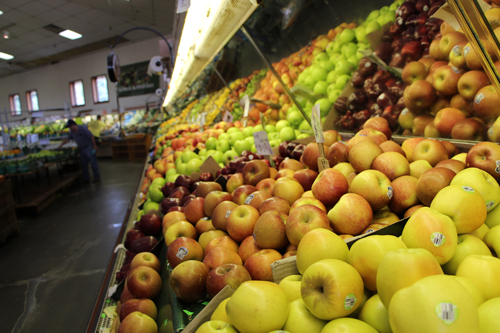About 1.4 million tons of food is wasted globally each year.
That’s ONE THIRD of all food produced in the entire world. With hundreds of millions of people suffering from crisis level or worse food insecurity in 2021, the waste of water and other resources to grow, harvest, transport and package food, plus food waste‘s impact on climate change… we need to do better.
We recently talked real turkey about food waste and gratitude (in honor of Thanksgiving). You’ll hear some crazy stats and helpful tips on how you can reduce food waste (and save money!) in your own home. Just in time for the upcoming holidays! Listen below:
The podcast mentioned a number of crazy food waste stats, tips for reducing food waste and ways to take action. Read on to learn more!
The Impact of Food Waste On People & Planet
It’s tragic that 1/3 of all food grown across the entire planet ends up uneaten. Here are some more crazy stats that will hopefully give you pause and become more mindful about your own food waste. (Scroll down for some tips on how to reduce food waste in your own household.)

- The number of people facing acute insecurity is in the hundreds of millions, but almost a billion people actually go to bed hungry at night. Almost 50 million people are on the edge of famine.
- In the US alone, more than 33 Million people—including more than 5 million children—suffered from food insecurity in 2021.
- Growing and processing, transportation, distribution, preparation, consumption and discarding the waste—contributes to climate change. Why? Each of these steps creates greenhouse gases that trap the sun’s heat. Boom. Climate change.
- Wasted food in America produces more greenhouse gas than 37 million cars, the majority of which is released by growing the food.
- 24% of this overall waste (and the majority of waste at the end of food’s lifecycle) ends up in landfills and contributes to 11 percent of the world’s greenhouse gases as methane, which is 86 times more powerful than carbon dioxide (in the podcast, we stated that methane is 27 times more potent, but found this updated statistic from NRDC in the writing of this blog post)
- The U.S. tosses away more food than any other country in the world: Nearly 40 million tons. 80 Billion pounds. That’s 30-40% of the entire U.S. food supply that goes uneaten. The equivalent of 90 billion meals and 219 pounds of waste per person. Here’s the breakdown of where the food waste comes from, according to rts):
- 43% American households
- 40% restaurants, grocers, food service companies
- 16% farms
- 2% manufacturers
- The average American family throws out $1600 annually in produce. (Feeding America).
- Uncertainty around expiration dates leads to about 20 percent of food waste in the home, according to a 2019 report from the FDA.
- Uneaten food consumes 14% of all fresh water use and 18% of all cropland use. ReFED
Tips for Reducing Food Waste At Home

- Compost (or get chickens!)
- Keep an inventory of what is in your fridge or pantry and get creative on how to use what is there before buying more!
- Don’t wash produce until ready to eat it! Moisture encourages decomposition and mold growth.
- Take produce out of plastic bags. Airtight wrappings suffocate fresh produce and speed up the decay process.
- Don’t rip off fruit stems. This is a new one to me! Once living cells are broken, microorganisms start to grow. Keep produce whole as long as possible.
- Be mindful when eating out. Take home leftovers and bring your own containers to reduce the 150 million tons of single-use plastic that we toss every year. Feeding America
- Eat the most perishable items first—raspberries last a few days; potatoes can hang around for about a month
- Make sunday hash out of leftovers before they go bad.
- Freeze produce (great for smoothies or some recipes) and leftovers before they go bad
- Understand expiration dates
- Best if Used by: Refers to quality: “where the product may not taste or perform, but is safe
- Use by: Applies to the few products that are highly perishable and/or have food safety concerns over time.
A Few Cool Global Food Waste Reduction Efforts…
- France requires restaurants to donate food that’s at risk of being tossed, but still safe to consume.
- In Denmark, you can use an app to find restaurants and bakeries that are about to close so you can purchase what’s left at a fraction of the cost!
- Cities in Sweden use food waste to fuel public bus transit (processed first, LOL)
- UNEP is playing a crucial role in the transition towards sustainable food systems. It serves as custodian of the food waste element of Sustainable Development Goal (SDG) 12.3, which aims to halve per capita global food waste at the retail and consumer levels and reduce food losses along production and supply chains.
- Food Recovery Challenge (FRC) asks organizations and businesses to “pledge to improve their sustainable food management practices and report their results.”
- Upcycling food products
- Donate unused foods to local communities in need
- Work with hauler partner to set up programs to make sure their organics are composted rather than sent to landfill.
Take GD Action
- Find out if your waste provider offers composting pickup service. If it does, take advantage!
- Start a neighborhood campaign to reduce food waste
- Start a neighborhood compost pile
- Donate to organizations that are working to reduce food waste. Here are some examples:
- Feeding America rescues food that would otherwise go to waste and distributes it to people in need
- REPLATE that’s working with food service companies and even restaurants to donate surplus food.
Please share your own food waste tips in the comments section! We’d love to hear from you!